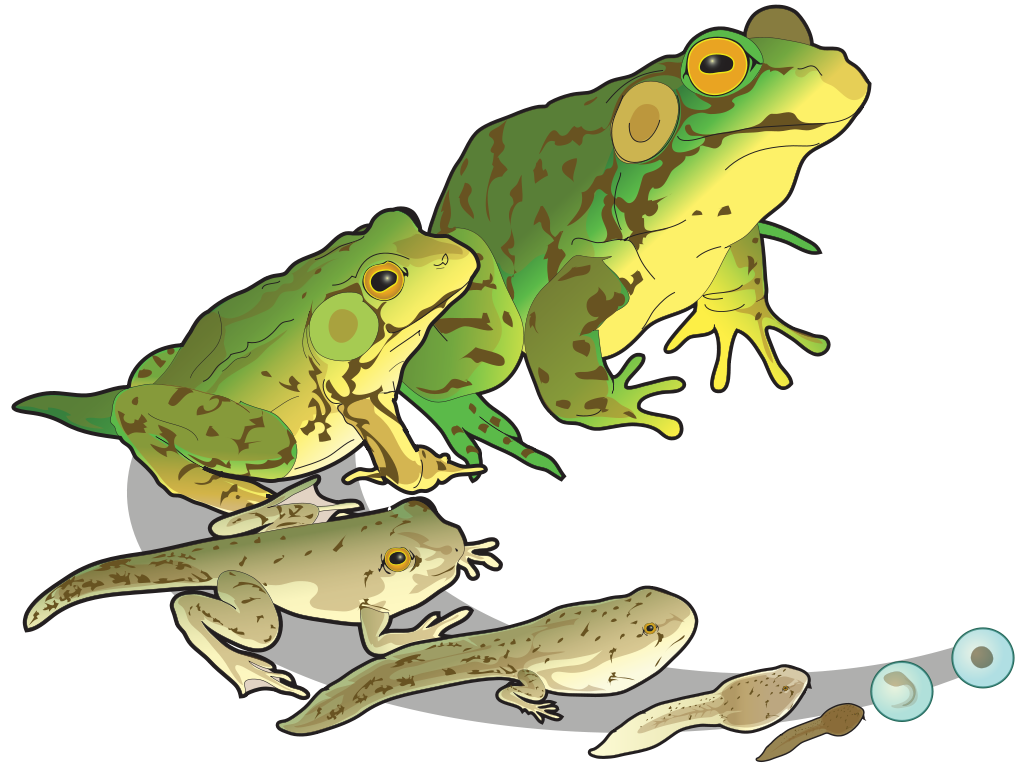15.11: The Life Cycle of Amphibians
- Page ID
- 44734
- Describe the important difference between the life cycle of amphibians and the life cycles of other vertebrates
Metamorphosis is a biological process by which an animal physically develops after birth or hatching, involving a conspicuous and relatively abrupt change in the animal’s body structure through cell growth and differentiation (Figure 1). Metamorphosis is iodothyronine-induced and an ancestral feature of all chordates.[1] Some insects, fishes, amphibians, mollusks, crustaceans, cnidarians, echinoderms and tunicates undergo metamorphosis, which is often accompanied by a change of nutrition source or behavior. Animals that goes through metamorphosis are called metamorphoses. Very few vertebrates undergo metamorphosis, but all the amphibians do to some extent.

Amphibians
In typical amphibian development, eggs are laid in water and larvae are adapted to an aquatic lifestyle. Frogs, toads, and newts all hatch from the eggs as larvae with external gills but it will take some time for the amphibians to interact outside with pulmonary respiration. Afterwards, newt larvae start a predatory lifestyle, while tadpoles mostly scrape food off surfaces with their horny tooth ridges.
Metamorphosis in amphibians is regulated by thyroxin concentration in the blood, which stimulates metamorphosis, and prolactin, which counteracts its effect. Specific events are dependent on threshold values for different tissues. Because most embryonic development is outside the parental body, development is subject to many adaptations due to specific ecological circumstances. For this reason tadpoles can have horny ridges for teeth, whiskers, and fins. They also make use of the lateral line organ. After metamorphosis, these organs become redundant and will be resorbed by controlled cell death, called apoptosis. The amount of adaptation to specific ecological circumstances is remarkable, with many discoveries still being made.
Frogs and toads
With frogs and toads, the external gills of the newly hatched tadpole are covered with a gill sac after a few days, and lungs are quickly formed. Front legs are formed under the gill sac, and hindlegs are visible a few days later. Following that there is usually a longer stage during which the tadpole lives off a vegetarian diet. Tadpoles use a relatively long, spiral‐shaped gut to digest that diet.
Rapid changes in the body can then be observed as the lifestyle of the frog changes completely. The spiral‐shaped mouth with horny tooth ridges is resorbed together with the spiral gut. The animal develops a big jaw, and its gills disappear along with its gill sac. Eyes and legs grow quickly, a tongue is formed, and all this is accompanied by associated changes in the neural networks (development of stereoscopic vision, loss of the lateral line system, etc.) All this can happen in about a day, so it is truly a metamorphosis (Figure 2). It is not until a few days later that the tail is reabsorbed, due to the higher thyroxin concentrations required for tail resorption.

Salamanders
Salamander development is highly diverse; some species go through a dramatic reorganization when transitioning from aquatic larvae to terrestrial adults, while others, such as the Axolotl, display paedomorphosis and never develop into terrestrial adults. Within the genus Ambystoma, species have evolved to be paedomorphic several times, and paedomorphosis and complete development can both occur in some species.[2]
Newts

In newts, there is no true metamorphosis because newt larvae already feed as predators and continue doing so as adults. Newts’ gills are never covered by a gill sac (Figure 3) and will be resorbed only just before the animal leaves the water. Just as in tadpoles, their lungs are functional early, but newts use them less frequently than tadpoles. Newts often have an aquatic phase in spring and summer, and a land phase in winter. For adaptation to a water phase, prolactin is the required hormone, and for adaptation to the land phase, thyroxin. External gills do not return in subsequent aquatic phases because these are completely absorbed upon leaving the water for the first time.
Caecilians
Basal caecilians such as Ichthyophis go through a metamorphosis in which aquatic larva transition into fossorial adults, which involves a loss of the lateral line.[3] More recently diverged caecilians (the Teresomata) do not undergo an ontogenetic niche shift of this sort and are in general fossorial throughout their lives. Thus, most caecilians do not undergo an anuran-like metamorphosis.[4]
- Robert J. Denver. Chordate Metamorphosis: Ancient Control by Iodothyronines. Current Biology, 2008, Vol 18 No 13, R567-9. DOI: 10.1016/j.cub.2008.05.024 ↵
- Laudet, Vincent. 2011. “The Origins and Evolution of Vertebrate Metamorphosis.” Current Biology 21: R726–R737 ↵
- Dunker, Nicole, Marvalee H. Wake, Wendy M. Olson. 2000. “Embryonic and Larval Development in the Caecilian Ichthyophis kohtaoensis (Amphibia, Gymnophiona): A Staging Table” Journal of Morphology 243: 3–34 ↵
- San Mauro, D., Gower, D. J., Oommen, O. V., Wilkinson, M. & Zardoya, R. 2004. "Phylogeny of caecilian amphibians (Gymnophiona) based on complete mitochondrial genomes and nuclear RAG1." Molecular Phylogenetics and Evolution 33: 413–427. ↵
Contributors and Attributions
- Adaptation and Revision of Metamorphosis. Authored by: Shelli Carter and Lumen Learning. Provided by: Lumen Learning. License: CC BY-SA: Attribution-ShareAlike
- Metamorphosis. Provided by: Wikipedia. Located at: https://en.Wikipedia.org/wiki/Metamorphosis. License: CC BY-SA: Attribution-ShareAlike
- Green frog life stages. Authored by: LadyofHats. Provided by: Wikipedia. Located at: https://commons.wikimedia.org/wiki/File:Greenfrog_life_stages.svg. License: CC0: No Rights Reserved

